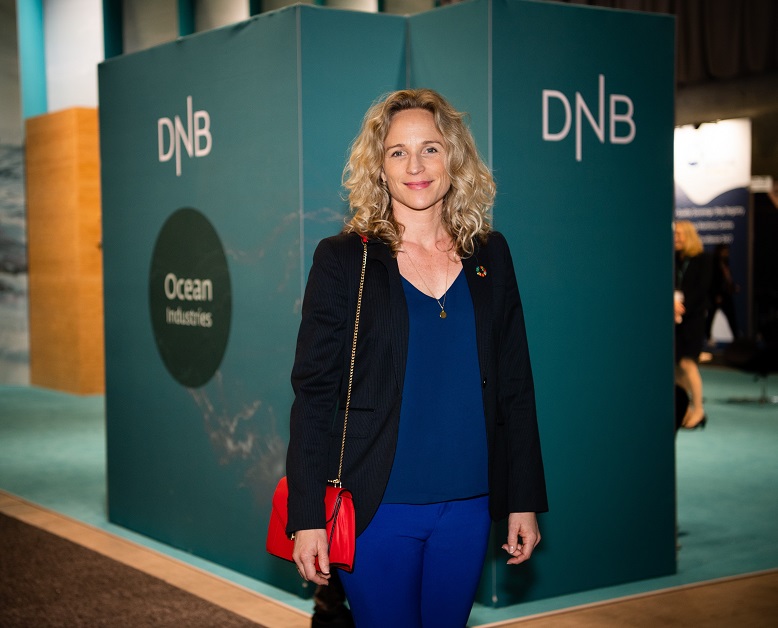Pia Meling VP Sales and Marketing for Massterly, the world’s first company set up to operate autonomous vessels, is more focused on getting trucks off the road than unmanned vessels on the water.
 The transition to autonomy, she says, is a ‘means rather than an end’, helping society tackle a pressing problem, while enhancing both the commercial and environmental sustainability of shipping.
The transition to autonomy, she says, is a ‘means rather than an end’, helping society tackle a pressing problem, while enhancing both the commercial and environmental sustainability of shipping.
“Drivers in Oslo spend around 145 hours a year in traffic jams,” said Pia Meling from her Oslo-based office. “That equates to 38 minutes of extra travel time every working day. In New York, where 90% of freight tonnage moves through the city on trucks, congestion cost the city USD 862million in lost economic activity in 2017 alone. Beyond the time, money and stress factors there’s pollution, with heavy trucks a major source of emissions, such as black carbon, damaging air quality and severely impacting on the environment and public health. People can view autonomy exclusively through the prism of technology, solely focusing on vessels and digitized infrastructure. But I think the benefits should be centre stage and - with the first generation of ships - the ability to move goods transportation from our roads to the sea (the EU has a target of shifting 50% of all goods transported under 300km by truck to sea or rail by 2050) is perhaps the key motivator. It is, quite simply, the solution to one of our biggest challenges.”
According to Pia, Massterly aims to help customers with existing ‘traditional’ tonnage as much as pioneering a new generation of unmanned vessels. “There’s a lot that can be done differently if you introduce digital/automation technology to ships and move select support services on shore,” she explained. “The benefits in terms of operational safety and efficiency, vessel and fleet management, and OPEX can be compelling. There’ll be a gradual transition rather than a switch, and Massterly is here to ‘hold hands’ and help our customers identify, enable and seize upon the opportunities delivering the greatest individual benefits.”
Although adapting existing tonnage will be big business, it doesn’t make for the biggest headlines. For those we have to look to Massterly’s fully autonomous projects and the aforementioned “forward thinking cargo owners”.
Early adopters
But the headlines come from Massterly’s big projects such as the Yara Birkeland, the world’s first fully autonomous vessel, a 120 TEU fully electric feeder ship is currently under construction in Romania and set for launch next year. Once active the ship will service a set route between Herøya and Brevik/Larvik, initially operating with a crew for comprehensive testing before the bridge is removed (physically) and full autonomy engaged. It is set to take between 25,000 and 40,000 truckloads of fertilizer off Norway’s overloaded road infrastructure per annum.
Less well-known are the plans of ASKO – the country’s largest grocery wholesaler and its leading distributor of food and fast-moving consumer products to supermarkets. “We’re working closely with ASKO, which is currently looking to build at least two fully electric autonomous RoRo vessels,” said Pia. “These would offer capacity for 16 trailers each, ferrying the cargo from one side of the Oslofjord to the other. In doing so the 66 m long ships, probably travelling at 6-8 knots for optimal energy efficiency, would save around one million truck kilometres a year.”
A question of cost
Although cost benefits will come, and there is an undoubted environmental gain, the
CAPEX for early operators will be high. “It’s likely that first generation autonomous vessels, especially when you add in the tailored infrastructure that will support them to optimise efficiency), will be more expensive than traditional alternatives. Nevertheless, OPEX will be reduced from day one of unmanned operations and, as yards begin to specialise in what will be a growth segment, technology costs drop with volume, and new innovations arrive, the overall price tag will decrease.
“I believe that future generations of autonomous vessels will be cheaper to build than traditional alternatives… but this will take time.”
Sustainable value
So, there is a price to pay for being a first mover - as much for Wilhelmsen and Kongsberg Maritime, as they build a new breed of business, as for shipowners - but there’s also an opportunity. And that’s not just restricted to OPEX savings.
“The world is changing,” said Pia. “Society, and particularly the younger generation, has a growing awareness of environmental issues and the need for sustainable solutions. Those that do not address their carbon footprint will struggle to recruit and retain new talent, while they may actively be punished when it comes to consumers exerting influence in terms of purchasing goods and services. In addition, both charterers and banks are now increasingly interested in low carbon shipping companies. There is an opening here for companies that are prepared to embrace innovation to benefit society’s stakeholders. They can position themselves for the future, enhance reputation and really connect with key audiences. I think companies such as Yara and ASKO are fully aware of that enormous potential.”
Although the goal of autonomous shipping is ambitious, Pia said that she wants people to reimagine transportation. “Autonomy can be the tool that enables a new approach, whereby the sea replaces road as the natural solution for relatively short distances. Instead of building new bridges, motorways and tunnels and suffocating, literally, under the ever-greater pressures of congestion, we can consider more ferries and feeder vessels, with greater reliability, better service, much lower cost and significantly lower carbon footprints.”
Photos: Pia Meling